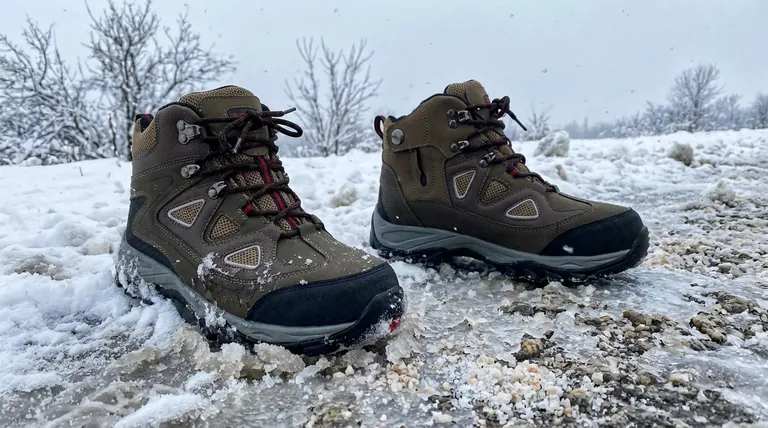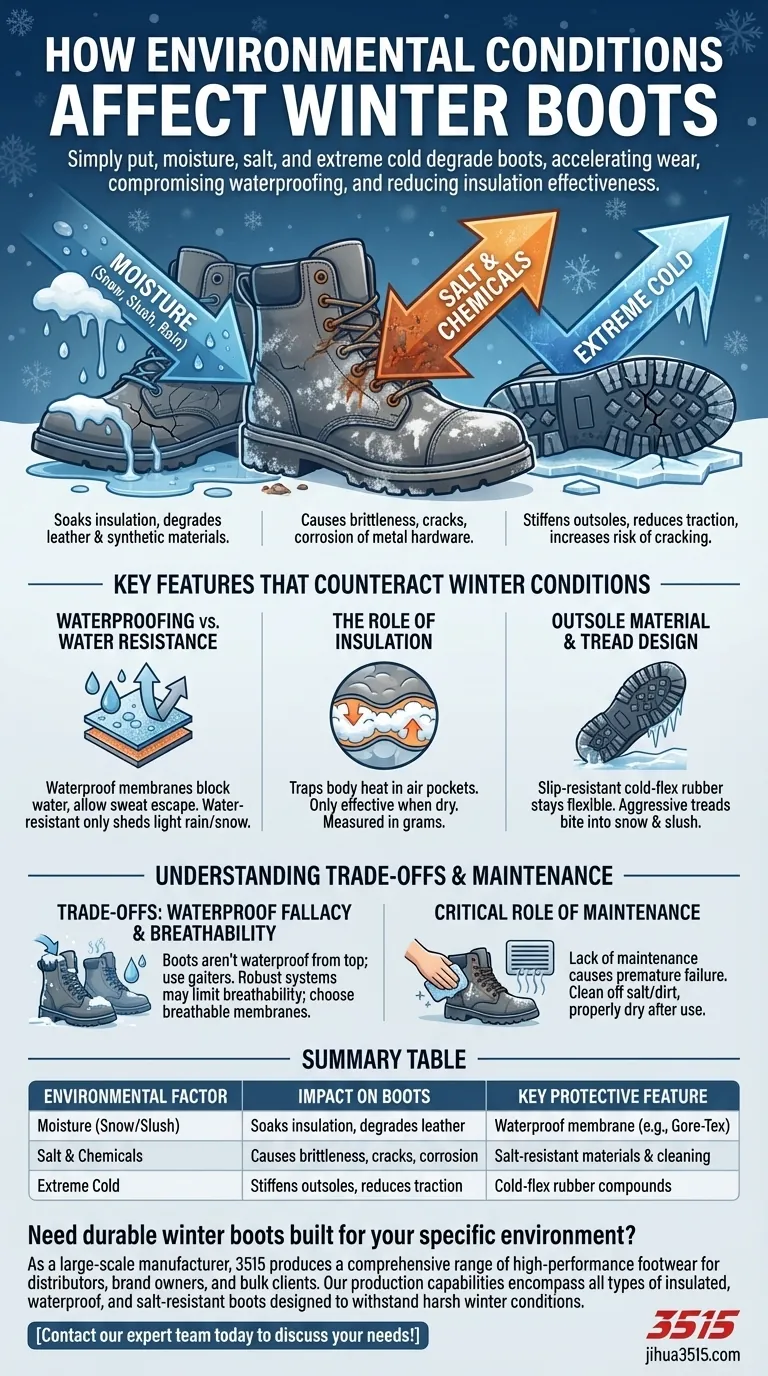Simply put, environmental conditions like moisture, salt, and extreme cold are the primary factors that degrade winter boots. They accelerate wear by breaking down materials, compromising waterproofing, and reducing the effectiveness of insulation, directly impacting both the lifespan and performance of your footwear.
The durability of your winter boots is not determined by a single feature, but by how well their specific materials and construction are matched to the primary environmental challenges you face—be it wet slush, corrosive salt, or deep, dry cold.

The Primary Environmental Adversaries
To understand how to protect your boots, you must first understand what you're protecting them from. Winter environments present a multi-faceted assault on footwear, with each element targeting a different weakness.
The Impact of Moisture (Snow, Slush, & Rain)
Moisture is the most pervasive threat. Once it penetrates the outer material, it can soak insulation, dramatically reducing its ability to keep you warm.
Prolonged exposure to water will degrade materials like leather, causing it to dry out, stiffen, and eventually crack. This is why a boot's water-handling capability is paramount.
The Corrosive Effect of Salt and Chemicals
Road salt and de-icing chemicals are exceptionally damaging. They pull moisture out of leather and synthetic materials, leaving them brittle and prone to cracking.
These chemicals also leave behind unsightly white stains and can corrode metal hardware like eyelets and lace hooks, compromising the boot's structural integrity over time.
The Challenge of Extreme Cold
Frigid temperatures affect the boot's components. Rubber and synthetic materials used in outsoles can become stiff and brittle in extreme cold, increasing the risk of cracking.
This stiffness also reduces traction, as the sole material is less able to conform to and grip icy or uneven surfaces.
Key Features That Counteract Winter Conditions
A well-designed winter boot is an engineered system, with each feature designed to combat a specific environmental threat. Understanding these features allows you to select the right tool for the job.
Waterproofing vs. Water Resistance
These terms are not interchangeable. Water-resistant boots, often made of treated leather, can shed light rain or snow for a short period but will eventually soak through.
Waterproof boots typically use a built-in membrane that physically blocks water from entering while allowing sweat and moisture from your foot to escape. This is critical for staying both dry and warm in slush or deep snow.
The Role of Insulation
Insulation creates pockets of trapped air, which is then warmed by your body heat to keep your feet warm. Its effectiveness is measured in grams, with higher numbers offering more warmth.
However, insulation is only effective when it's dry. This is why waterproofing and insulation are a critical team; one is nearly useless in harsh conditions without the other.
Outsole Material and Tread Design
The outsole is your connection to the ground. A good winter boot features a slip-resistant rubber compound designed to stay flexible in cold temperatures.
The tread design, or lug pattern, is engineered to bite into snow and shed slush, providing stable traction on hazardous surfaces.
Understanding the Trade-offs and Limitations
Even the highest quality boots have limitations. Being aware of these common pitfalls ensures you use and care for your gear effectively.
The "Waterproof" Fallacy
A boot can be perfectly waterproof, but it won't stop snow or water from coming in over the top cuff.
In deep snow, this is a common point of failure. It can be prevented by wearing waterproof pants over the boots or by using accessories like ankle gaiters.
The Breathability Compromise
The most robust waterproofing systems can sometimes limit breathability. If your feet sweat heavily, that moisture can get trapped, making your socks damp and your feet cold.
Look for boots with breathable waterproof membranes to strike the best balance between keeping external moisture out and letting internal moisture escape.
The Critical Role of Maintenance
No boot is indestructible. The single biggest factor in premature failure is a lack of maintenance.
Allowing salt and dirt to sit on boots will slowly destroy them. Failing to properly dry them after use can lead to material rot and odor.
Making the Right Choice for Your Goal
Select your boots based on a realistic assessment of your most common winter environment.
- If your primary focus is urban commuting (slush and salt): Prioritize excellent waterproofing and materials that are easy to clean and resistant to salt damage.
- If your primary focus is deep snow and recreation: Look for taller boots with a high insulation rating and deep, aggressive sole treads for traction.
- If your primary focus is extreme, dry cold: Emphasize the insulation rating (grams) and an outsole specifically designed to remain flexible in frigid temperatures.
Ultimately, choosing the right boot and caring for it properly is the key to ensuring your feet stay warm, dry, and comfortable through the worst of winter.
Summary Table:
| Environmental Factor | Impact on Boots | Key Protective Feature |
|---|---|---|
| Moisture (Snow/Slush) | Soaks insulation, degrades leather | Waterproof membrane (e.g., Gore-Tex) |
| Salt & Chemicals | Causes brittleness, cracks, corrosion | Salt-resistant materials & cleaning |
| Extreme Cold | Stiffens outsoles, reduces traction | Cold-flex rubber compounds |
Need durable winter boots built for your specific environment?
As a large-scale manufacturer, 3515 produces a comprehensive range of high-performance footwear for distributors, brand owners, and bulk clients. Our production capabilities encompass all types of insulated, waterproof, and salt-resistant boots designed to withstand harsh winter conditions.
Let us help you source or develop the perfect winter boot solution for your market. Contact our expert team today to discuss your needs!
Visual Guide

Related Products
- Safety Footwear Wholesale Manufacturer for Custom OEM/ODM Production
- Premium Wholesale Waterproof Safety Boots High Performance Protection for Industrial Markets
- Wholesale Safety Footwear Manufacturer for Bulk & Custom OEM Orders
- Premium Flame-Retardant Waterproof Safety Boots and Shoes
- High Performance Fire-Retardant Waterproof Safety Boots
People Also Ask
- What cultural and environmental considerations are tied to wearing shoes indoors? Balance Hygiene, Tradition, and Foot Health
- What are the differences between steel toe, composite toe, and alloy toe Wellington boots? Choose the Right Safety Toe for Your Job
- What are OSHA approved shoes? Understanding the Correct Standards for Workplace Safety
- Is it normal to wear shoes in the house? A Guide to Hygiene, Comfort & Culture
- Do snake bite boots work? Your Ultimate Guide to Effective Snake Bite Protection



















